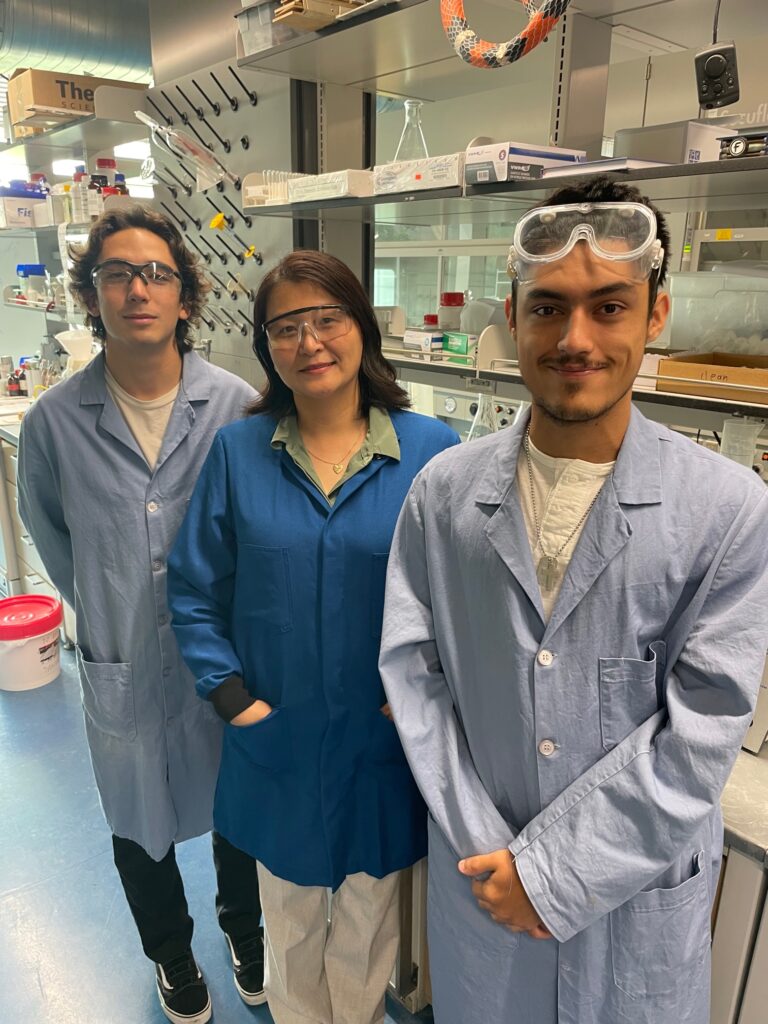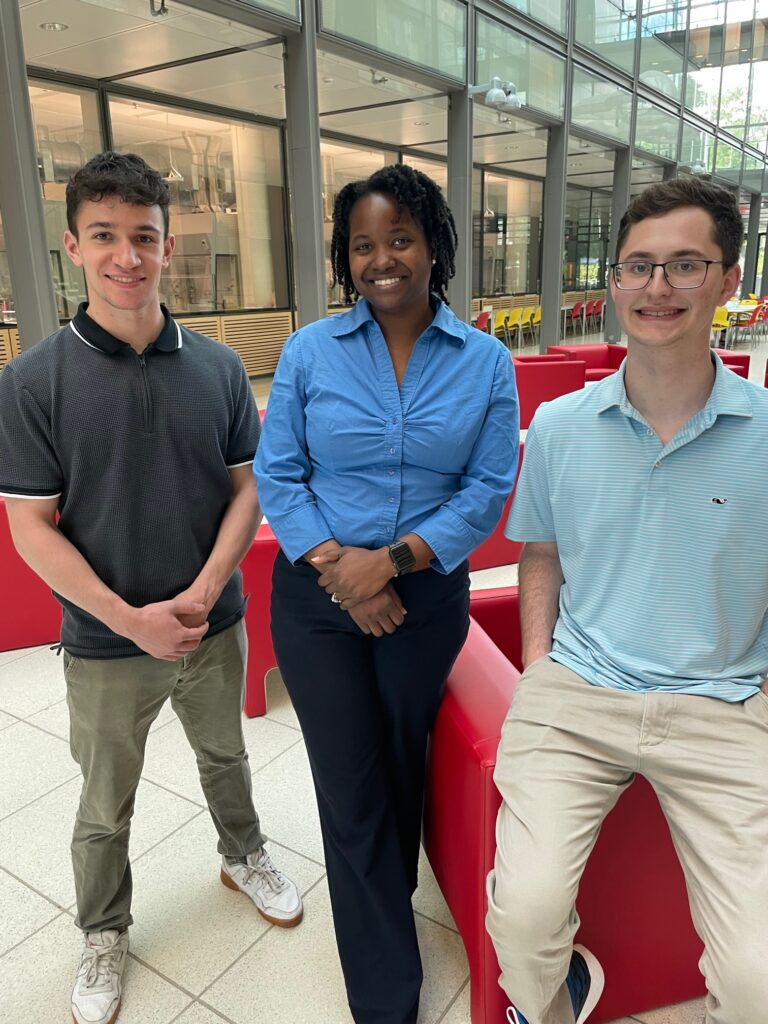Visiting Faculty, Students Enliven Frick Lab
For the second year running, Princeton Chemistry hosts its Visiting Faculty Research Partnership (VFRP), drawing faculty and students from partner institutions into a summer of research and fellowship at Frick Lab.
Three sets of visitors comprise the 2023 cohort, each with a professor and two trailing students. They hail from California Baptist University in Riverside, California; Hampton University in Hampton, Virginia; and, in a return visit, Rowan University in Glassboro, New Jersey.
Seeking to build a broader network through an idea broached just three years ago, Chemistry Department leadership notes today that VFRP has become one of its most successful outreach projects, in which participants are paired with a member of the faculty to work closely on a selected research project. The program stretches over two months.
Here are our 2023 VFRP visitors.
From Hampton University
Hampton University is a Historically Black College and University (HBCU) one hour outside of Richmond, Virginia, offering technical, liberal arts, and graduate degree programs. Graham Chakafana is an assistant professor in the Department of Chemistry and Biochemistry there. He and his students applied for the VFRP program, Chakafana said, largely for the mentorship and development of new collaborations, which they found working on a project with the Kleiner Lab.

Assistant Professor in the Department of Chemistry and Biochemistry at Hampton University Graham Chakafana, center; and undergraduates Dillon Bethea (left, standing), and Keziah Harris.
“I’m just starting out as a faculty member, so to be able to catch up on some of the changes in the field and have this mentorship—for me and my students—at a prestigious institution was just a great opportunity,” said Chakafana, who completed his postdoctoral work at Stanford University last year.
Their research involves the biochemical characterization of Plasmodium falciparum UMP/CMP kinase protein. Plasmodium falciparum is the parasite that causes malaria, and the protein is what helps keep it alive. Determining the protein’s structure may give researchers a leg up on therapies that can selectively thwart the parasite in the human body.
“When I first approached Ralph, I had a different project in mind,” said Chakafana. “And then he put in a lot of time helping me design it and coming up with wonderful ideas, saying ‘Let’s change this, I think that will work.’ It’s been quite a team to work with, Ralph and his lab. I’ve learned a lot in a short time.”
Keziah Harris, a rising junior at Hampton, is pleased with the choice of biochemistry as her field of study. But the experience this summer, she said, has sharpened an awareness of her options within that major.
“I think this summer has had a lot of influence on me,” said Harris, who grew up in Arizona. “I’ve always thought I’d end up working in a hospital with patients one-on-one. But I don’t know now. I’m still trying to decide because I really like the research in the lab. This has definitely broadened my experience.”
Rising sophomore Dillon Bethea appreciates all the resources on campus, from the lab to Dillon Gym. A lacrosse player, Bethea said he has felt thoroughly welcomed among the athletes on campus this summer.
“I would say the community here is one of the things I like best. It’s very supportive and welcoming,” said Bethea. “Walking into Dillon Gym for the first time, there were just so many people striving to improve themselves, which I am always trying to do. You don’t need to worry about being an outsider. You’re just welcomed in.”
From California Baptist University
Located an hour outside of Los Angeles, California Baptist is a masters-granting university whose enrollment has more than doubled in the past 10 years, according to Professor of Chemistry Ying (Hannah) Hu. Most of its students commute to campus and live in the surrounding area. Hu brought along two students who took her organic chemistry courses two years ago—Ryan Rebelo and Nicolas Rojas—and excelled in them.

California Baptist University's Professor of Chemistry Ying (Hannah) Hu (center), with undergraduates Ryan Rebelo and Nicolas Rojas.
Fresh off a session learning how to make use of Frick’s photo NMR machine to refine their research assay, Hu said their project has a clearer direction this summer under the support of the Sorensen Lab.
“We are investigating the stability and photoinduced reactions of 2,2-Diphenyl-1-Picrylhydrazyl (DPPH) in several solvents. DPPH is a purple nitrogen-containing radical and is frequently used in the antioxidant activity test in food science,” said Hu. “But its stability has always been questioned. Now, with thanks to Erik and his research group, we feel like we finally landed on solid ground with this research. We were taking it on faith before. But now, with the NMR instrument, we have found a good direction and a clearer picture of how this radical behaves.”
Rising senior Rojas has never lived in a dorm before. So along with the novelty of research in a large lab staffed with graduate students, he’s had the experience of meeting summer students from Spain, Montenegro, and Italy.
“Just being able to work alongside all these brilliants mind and all these friendly grad students is a privilege,” said Rojas, a biochemical science major. “You’re just running into people from all over the world who are here to do research, trying to learn something. I’ve never done anything like this.”
Fellow rising senior Rebelo, a forensic chemistry major, said he’s been most impressed with the way facilities and resources enable scientists to go farther with their work.
“Before we came here, we’d hit a speedbump,” he said. “But we’ve just been asking questions and exploring how they do things here. I like the idea of how freeing it is. If you have an idea, you can test it out. There are so many resources here that I can find a way to do it.”
From Rowan University
Rashanique Quarels, an assistant professor of chemistry and biochemistry, was among VFRP’s inaugural cohort last year. She found her collaboration with the Knowles Lab so productive that she kept the relationship going through the year in anticipation of a second season at Frick.

Rowan University Assistant Professor of Chemistry and Biochemistry Rashanique Quarels (center), with her students Jonathan Santoro (left) and Zachary Coren.
“I put a lot of pressure on myself to utilize the resources while I have them available to me. Having that has been so beneficial to our work,” said Quarels. “I wanted to continue the partnership because the Knowles Lab has been so hospitable, and we were able to get a lot done last summer.”
This summer, Quarels is having her trailing students, Jonathan Santoro and Zachary Coren, synthesize organic and iridium photocatalysts to further refine the photoreduction methods they’re developing as a part of her project to make carbon- and oxygen-centered radicals from aryl tosylates.
Santoro, a rising senior, is returning to Princeton Chemistry, too.
“I made the decision to come back because I’ve been working on this research with Dr. Quarels for two years, trying to build my skills in organic synthesis,” Santoro said. “What I like about the research is that, with the reaction we’re working on now, we don’t know what the end product is and we’re trying to find that out. I like trying to find the answer. And we can use all the machines here to help us do that.”
This summer, in his first visit to Princeton, Coren said he is most impressed by the work ethic of the graduate students.
“They love what they’re doing, all the grad students,” Coren said. “It’s more than just the research. They’re here to make connections and to try to bring something more than just themselves to the field.”
Santoro added one more favorite: “I have a full meal plan and the food is just so good. It’s like you have gourmet chefs here.”
